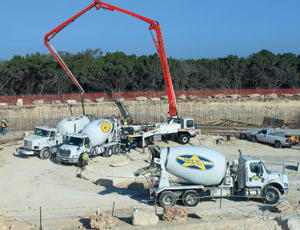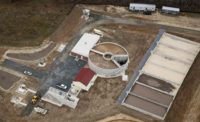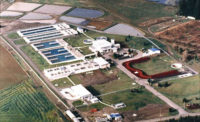Austin's $508-million Water Treatment Plant No. 4 required engineers and contractors to creatively address a host of environmental concerns to ensure that the city could provide enough water for its growing population through the century.

“It's a backbone project for us, not just in terms of the next few years but for decades to come,” says Greg Meszaros, director of the Austin Water Utility. Participants not only have to build the plant on a hilltop, but also construct new tunnels burrowing under a nature preserve and intakes siphoning water from the bottom of a recreational lake ringed by pricey homes.
The project consists of an intake structure at Lake Travis, a tunnel system that brings the water to a 92-acre site with a conventional 50-million-gallon-per-day (mgd) capacity treatment plant. Once purified, the water will enter a 7-mile tunnel and connect to the city's Jollyville Reservoir.
“We're tunneling through hard rock, putting an intake structure into one of the largest recreational lakes in Texas and operating in an environmentally sensitive area,” says Larry A. Laws, project manager for MWH Constructors, Broomfield, Colo., which has the $359-million construction management-at-risk contract. “A lot of things have to come together to make this work, which is why they chose a CM-at-risk model.”
The project represents Austin Water's first use of that project delivery method, which allowed the city utility to have one construction firm to deal with and to select that company based on qualifications.
“We hired MWH and integrated it into the design team,” Meszaros says. MWH has overall responsibility for all of the construction packages. “I call it, ‘only one throat to choke,'” Meszaros jokes.
Some 250 to 350 people will work at the site. Tunneling operations are expected to run 24 hours a day.
Intake from Lake Travis
Water will come from Lake Travis, a flood-control lake on Texas' Colorado River, and the facility will ultimately be capable of drawing 300 mgd. Meszaros says this will be the first time Austin will be drawing water from the recreational lake, although it takes some supply from two other locations along the river.
Paul Walker, partner with Carollo Engineers in Austin, the engineering firm for the intake and plant portions, says the tunnels are the project's most complex part. “The methodology of tunneling under the lake and tapping in at the bottom with an intake structure is not common,” he says.
Three intake structures—with concrete foundations and stainless-steel screens—will be placed at different depths of the lake. The water surface varies from 614 ft above mean sea level to 720 ft, says Shelby Eckols, project manager for AECOM, subcontractor to Carollo for the intake portion. In order to get the best quality water, Austin Water has to stay within the upper 50 ft of the surface in placing intakes, he says.
“Depending on the time of the year and the temperature of the water, that optimum layer varies in depth,” says Laws.
The intake structures are placed in approximately 160 to 180 ft of water. AECOM designed the mushroom-shaped intakes to be attractive and not an eyesore when the water level drops.
The 30-ft-dia., 20-ft-tall intakes are designed so the velocity is less than one-half-foot per second to make sure fish are not trapped in the exteriors of the screens, Eckols says. From the screen houses, the water enters 9-ft-dia. pipes that connect to a 9-ft-dia. pipe that runs along the lake bottom to the tunnel.
Austin Hill Country Constructors, San Francisco, a joint venture between Obayashi Corp., Los Angeles, and Manson Construction, Seattle, will complete the raw tunnel work and the intake structure, requiring barges and cranes.
“We will have one single point of responsibility for that critical connection to the lake,” Laws says.
That intake structure at lake bottom will connect to a 1-mile-long, concrete-lined tunnel, bored from the land side. It is 450 ft below grade to avoid the Edwards Plateau and cave invertebrates. Crews will first have to place safety plugs at the lake access until the tunnel is in place, and then lift them out. The water will flow to an intermediate pumping station, about halfway up the hill to the treatment plant.
Crews will drill a 450-ft-deep, 25-ft-wide access shaft through rock to reach the tunnel depth, using a vertical sinker to grind the rock out in 4-ft to 5-ft lifts. Hill Country then places concrete rings in to reinforce the sides of the shaft before grinding another 4 to 5 ft. “At the bottom, you end up with a 45-story concrete doughnut lining the inside of the shaft,” Laws says.
A crane, specially manufactured in Austria, will lower equipment into the hole and lift tunnel spoils out. “That crane will be able to lift things up to 50,000 pounds from the bottom in about a minute,” Laws says.
Hill Country will then assemble the road header— which looks like a ball with spikes on it—at the bottom of the shaft. Once together, crews will use it to grind the rock as the 9-ft-dia. tunnel progresses to the lake.
Article toolbar



Post a comment to this article
Report Abusive Comment